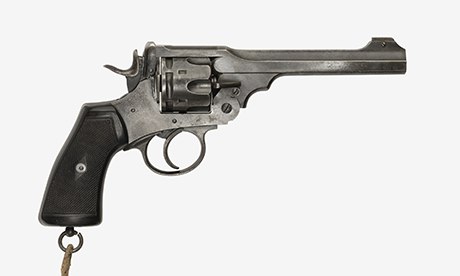
A revolver owned by JRR Tolkien during his time serving as a signal officer at the Battle of the Somme has gone on display at the Imperial War Museum North, in Manchester, ahead of four years of events to mark the centenary of the first world war.
Tolkien served on the frontline as a signals officer for the Lancashire Fusiliers from June to October 1916, when he contracted trench fever and was sent to a hospital in Birmingham. There he began writing stories which became The Silmarillion, the legendary history of Middle-earth which underlies The Hobbit and The Lord of the Rings.
John Garth, whose 2003 biography, Tolkien and the Great War: The Threshold of Middle-earth, draws on letters written by Tolkien in order to understand the influence of the first world war on his work, said: "Tolkien lost two of his three closest friends on the Somme, a loss he talks about in the foreword to The Lord of the Rings. Like the rest of his generation, he also lost a world, which was replaced by the modern one. From the outset, the war seems to have stirred his creativity. It made him realise that he wanted to write and that he had no time to waste."
The Webley Mk VI was the standard issue gun for British servicemen at the outbreak of the war. In 1996, Tolkien's family gave the gun to the Imperial War Museum during a firearms amnesty in the UK, following the Dunblane school massacre, in which 16 children and one adult were killed. As a signalman, Tolkien took charge of communications for his battalion; it is not known if he used the weapon in battle.
Garth continued: "An Oxford-educated man, he went to war alongside labourers and miners, like Bilbo among the dwarves. He saw and probably experienced war trauma – and Frodo's psychological journey is remarkably like the ones described by war writers such as Siegfried Sassoon. Tolkien witnessed pitiable waste of life in the mud, which shaped his famous Dead Marshes scene, where bodies of warriors appear like ghosts in the marsh pools. His passions were medieval, but his work was a response to indelible experience."
"He also said that Sam Gamgee, in The Lord of the Rings, was 'a reflexion of the English soldier, of the privates and batmen I knew in the 1914 war, and recognised as so far superior to myself'."
There were over a million casualties during the Battle of the Somme in the summer and autumn of 1916. The exhibition at the Imperial War Museum North coincides with the cinema release of The Hobbit: The Desolation of Smaug this month.
Graham Boxer, director of IWM North, said: "Visitors will be able to see this weapon and connect further with Tolkien's magical stories which were born from harrowing wartime experiences."
The Imperial War Museum's five premises, which also include its flagship museum in London, the Churchill War Rooms and the second world war cruiser ship HMS Belfast, will run a four-year programme of activities nationwide from 2014 to mark the centenary of the first world war.
• This article was amended on 16 December 2013. An earlier version said Tolkien began working on drafts of The Lord of the Rings and The Hobbit in 1916. That is not the case but he did begin writing stories which became The Silmarillion. It also said there were 1 million deaths at the Battle of the Somme; in fact there were 1 million casualties. A description of Tolkien as a signalman has been amended to signals officer.

